Zongyang Ma
Are Large Language Models Chronically Online Surfers? A Dataset for Chinese Internet Meme Explanation
Oct 01, 2025Abstract:Large language models (LLMs) are trained on vast amounts of text from the Internet, but do they truly understand the viral content that rapidly spreads online -- commonly known as memes? In this paper, we introduce CHIME, a dataset for CHinese Internet Meme Explanation. The dataset comprises popular phrase-based memes from the Chinese Internet, annotated with detailed information on their meaning, origin, example sentences, types, etc. To evaluate whether LLMs understand these memes, we designed two tasks. In the first task, we assessed the models' ability to explain a given meme, identify its origin, and generate appropriate example sentences. The results show that while LLMs can explain the meanings of some memes, their performance declines significantly for culturally and linguistically nuanced meme types. Additionally, they consistently struggle to provide accurate origins for the memes. In the second task, we created a set of multiple-choice questions (MCQs) requiring LLMs to select the most appropriate meme to fill in a blank within a contextual sentence. While the evaluated models were able to provide correct answers, their performance remains noticeably below human levels. We have made CHIME public and hope it will facilitate future research on computational meme understanding.
STAR-R1: Spatial TrAnsformation Reasoning by Reinforcing Multimodal LLMs
May 26, 2025Abstract:Multimodal Large Language Models (MLLMs) have demonstrated remarkable capabilities across diverse tasks, yet they lag significantly behind humans in spatial reasoning. We investigate this gap through Transformation-Driven Visual Reasoning (TVR), a challenging task requiring identification of object transformations across images under varying viewpoints. While traditional Supervised Fine-Tuning (SFT) fails to generate coherent reasoning paths in cross-view settings, sparse-reward Reinforcement Learning (RL) suffers from inefficient exploration and slow convergence. To address these limitations, we propose STAR-R1, a novel framework that integrates a single-stage RL paradigm with a fine-grained reward mechanism tailored for TVR. Specifically, STAR-R1 rewards partial correctness while penalizing excessive enumeration and passive inaction, enabling efficient exploration and precise reasoning. Comprehensive evaluations demonstrate that STAR-R1 achieves state-of-the-art performance across all 11 metrics, outperforming SFT by 23% in cross-view scenarios. Further analysis reveals STAR-R1's anthropomorphic behavior and highlights its unique ability to compare all objects for improving spatial reasoning. Our work provides critical insights in advancing the research of MLLMs and reasoning models. The codes, model weights, and data will be publicly available at https://github.com/zongzhao23/STAR-R1.
DetailFusion: A Dual-branch Framework with Detail Enhancement for Composed Image Retrieval
May 23, 2025Abstract:Composed Image Retrieval (CIR) aims to retrieve target images from a gallery based on a reference image and modification text as a combined query. Recent approaches focus on balancing global information from two modalities and encode the query into a unified feature for retrieval. However, due to insufficient attention to fine-grained details, these coarse fusion methods often struggle with handling subtle visual alterations or intricate textual instructions. In this work, we propose DetailFusion, a novel dual-branch framework that effectively coordinates information across global and detailed granularities, thereby enabling detail-enhanced CIR. Our approach leverages atomic detail variation priors derived from an image editing dataset, supplemented by a detail-oriented optimization strategy to develop a Detail-oriented Inference Branch. Furthermore, we design an Adaptive Feature Compositor that dynamically fuses global and detailed features based on fine-grained information of each unique multimodal query. Extensive experiments and ablation analyses not only demonstrate that our method achieves state-of-the-art performance on both CIRR and FashionIQ datasets but also validate the effectiveness and cross-domain adaptability of detail enhancement for CIR.
STAR-R1: Spacial TrAnsformation Reasoning by Reinforcing Multimodal LLMs
May 21, 2025Abstract:Multimodal Large Language Models (MLLMs) have demonstrated remarkable capabilities across diverse tasks, yet they lag significantly behind humans in spatial reasoning. We investigate this gap through Transformation-Driven Visual Reasoning (TVR), a challenging task requiring identification of object transformations across images under varying viewpoints. While traditional Supervised Fine-Tuning (SFT) fails to generate coherent reasoning paths in cross-view settings, sparse-reward Reinforcement Learning (RL) suffers from inefficient exploration and slow convergence. To address these limitations, we propose STAR-R1, a novel framework that integrates a single-stage RL paradigm with a fine-grained reward mechanism tailored for TVR. Specifically, STAR-R1 rewards partial correctness while penalizing excessive enumeration and passive inaction, enabling efficient exploration and precise reasoning. Comprehensive evaluations demonstrate that STAR-R1 achieves state-of-the-art performance across all 11 metrics, outperforming SFT by 23% in cross-view scenarios. Further analysis reveals STAR-R1's anthropomorphic behavior and highlights its unique ability to compare all objects for improving spatial reasoning. Our work provides critical insights in advancing the research of MLLMs and reasoning models. The codes, model weights, and data will be publicly available at https://github.com/zongzhao23/STAR-R1.
iMOVE: Instance-Motion-Aware Video Understanding
Feb 18, 2025



Abstract:Enhancing the fine-grained instance spatiotemporal motion perception capabilities of Video Large Language Models is crucial for improving their temporal and general video understanding. However, current models struggle to perceive detailed and complex instance motions. To address these challenges, we have made improvements from both data and model perspectives. In terms of data, we have meticulously curated iMOVE-IT, the first large-scale instance-motion-aware video instruction-tuning dataset. This dataset is enriched with comprehensive instance motion annotations and spatiotemporal mutual-supervision tasks, providing extensive training for the model's instance-motion-awareness. Building on this foundation, we introduce iMOVE, an instance-motion-aware video foundation model that utilizes Event-aware Spatiotemporal Efficient Modeling to retain informative instance spatiotemporal motion details while maintaining computational efficiency. It also incorporates Relative Spatiotemporal Position Tokens to ensure awareness of instance spatiotemporal positions. Evaluations indicate that iMOVE excels not only in video temporal understanding and general video understanding but also demonstrates significant advantages in long-term video understanding.
mR$^2$AG: Multimodal Retrieval-Reflection-Augmented Generation for Knowledge-Based VQA
Nov 22, 2024



Abstract:Advanced Multimodal Large Language Models (MLLMs) struggle with recent Knowledge-based VQA tasks, such as INFOSEEK and Encyclopedic-VQA, due to their limited and frozen knowledge scope, often leading to ambiguous and inaccurate responses. Thus, multimodal Retrieval-Augmented Generation (mRAG) is naturally introduced to provide MLLMs with comprehensive and up-to-date knowledge, effectively expanding the knowledge scope. However, current mRAG methods have inherent drawbacks, including: 1) Performing retrieval even when external knowledge is not needed. 2) Lacking of identification of evidence that supports the query. 3) Increasing model complexity due to additional information filtering modules or rules. To address these shortcomings, we propose a novel generalized framework called \textbf{m}ultimodal \textbf{R}etrieval-\textbf{R}eflection-\textbf{A}ugmented \textbf{G}eneration (mR$^2$AG), which achieves adaptive retrieval and useful information localization to enable answers through two easy-to-implement reflection operations, preventing high model complexity. In mR$^2$AG, Retrieval-Reflection is designed to distinguish different user queries and avoids redundant retrieval calls, and Relevance-Reflection is introduced to guide the MLLM in locating beneficial evidence of the retrieved content and generating answers accordingly. In addition, mR$^2$AG can be integrated into any well-trained MLLM with efficient fine-tuning on the proposed mR$^2$AG Instruction-Tuning dataset (mR$^2$AG-IT). mR$^2$AG significantly outperforms state-of-the-art MLLMs (e.g., GPT-4v/o) and RAG-based MLLMs on INFOSEEK and Encyclopedic-VQA, while maintaining the exceptional capabilities of base MLLMs across a wide range of Visual-dependent tasks.
E.T. Bench: Towards Open-Ended Event-Level Video-Language Understanding
Sep 26, 2024



Abstract:Recent advances in Video Large Language Models (Video-LLMs) have demonstrated their great potential in general-purpose video understanding. To verify the significance of these models, a number of benchmarks have been proposed to diagnose their capabilities in different scenarios. However, existing benchmarks merely evaluate models through video-level question-answering, lacking fine-grained event-level assessment and task diversity. To fill this gap, we introduce E.T. Bench (Event-Level & Time-Sensitive Video Understanding Benchmark), a large-scale and high-quality benchmark for open-ended event-level video understanding. Categorized within a 3-level task taxonomy, E.T. Bench encompasses 7.3K samples under 12 tasks with 7K videos (251.4h total length) under 8 domains, providing comprehensive evaluations. We extensively evaluated 8 Image-LLMs and 12 Video-LLMs on our benchmark, and the results reveal that state-of-the-art models for coarse-level (video-level) understanding struggle to solve our fine-grained tasks, e.g., grounding event-of-interests within videos, largely due to the short video context length, improper time representations, and lack of multi-event training data. Focusing on these issues, we further propose a strong baseline model, E.T. Chat, together with an instruction-tuning dataset E.T. Instruct 164K tailored for fine-grained event-level understanding. Our simple but effective solution demonstrates superior performance in multiple scenarios.
EA-VTR: Event-Aware Video-Text Retrieval
Jul 10, 2024



Abstract:Understanding the content of events occurring in the video and their inherent temporal logic is crucial for video-text retrieval. However, web-crawled pre-training datasets often lack sufficient event information, and the widely adopted video-level cross-modal contrastive learning also struggles to capture detailed and complex video-text event alignment. To address these challenges, we make improvements from both data and model perspectives. In terms of pre-training data, we focus on supplementing the missing specific event content and event temporal transitions with the proposed event augmentation strategies. Based on the event-augmented data, we construct a novel Event-Aware Video-Text Retrieval model, ie, EA-VTR, which achieves powerful video-text retrieval ability through superior video event awareness. EA-VTR can efficiently encode frame-level and video-level visual representations simultaneously, enabling detailed event content and complex event temporal cross-modal alignment, ultimately enhancing the comprehensive understanding of video events. Our method not only significantly outperforms existing approaches on multiple datasets for Text-to-Video Retrieval and Video Action Recognition tasks, but also demonstrates superior event content perceive ability on Multi-event Video-Text Retrieval and Video Moment Retrieval tasks, as well as outstanding event temporal logic understanding ability on Test of Time task.
How to Make Cross Encoder a Good Teacher for Efficient Image-Text Retrieval?
Jul 10, 2024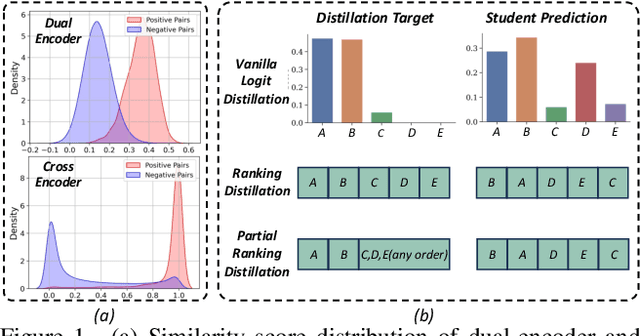
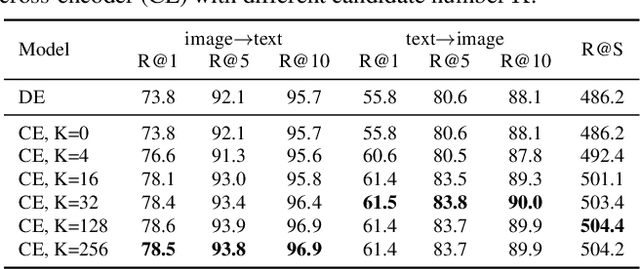
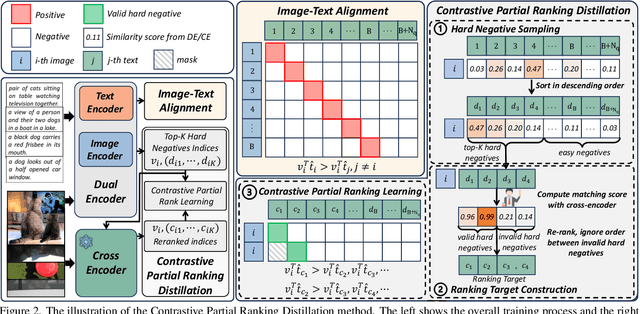
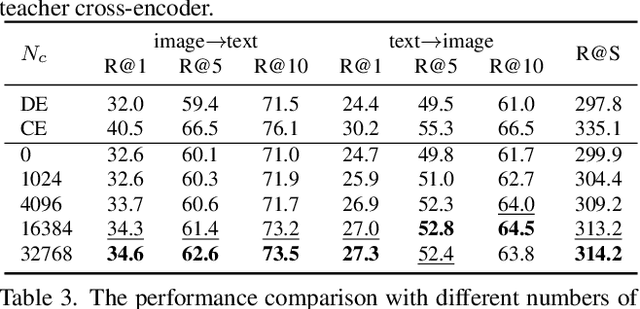
Abstract:Dominant dual-encoder models enable efficient image-text retrieval but suffer from limited accuracy while the cross-encoder models offer higher accuracy at the expense of efficiency. Distilling cross-modality matching knowledge from cross-encoder to dual-encoder provides a natural approach to harness their strengths. Thus we investigate the following valuable question: how to make cross-encoder a good teacher for dual-encoder? Our findings are threefold:(1) Cross-modal similarity score distribution of cross-encoder is more concentrated while the result of dual-encoder is nearly normal making vanilla logit distillation less effective. However ranking distillation remains practical as it is not affected by the score distribution.(2) Only the relative order between hard negatives conveys valid knowledge while the order information between easy negatives has little significance.(3) Maintaining the coordination between distillation loss and dual-encoder training loss is beneficial for knowledge transfer. Based on these findings we propose a novel Contrastive Partial Ranking Distillation (CPRD) method which implements the objective of mimicking relative order between hard negative samples with contrastive learning. This approach coordinates with the training of the dual-encoder effectively transferring valid knowledge from the cross-encoder to the dual-encoder. Extensive experiments on image-text retrieval and ranking tasks show that our method surpasses other distillation methods and significantly improves the accuracy of dual-encoder.
CREATE: A Benchmark for Chinese Short Video Retrieval and Title Generation
Mar 31, 2022

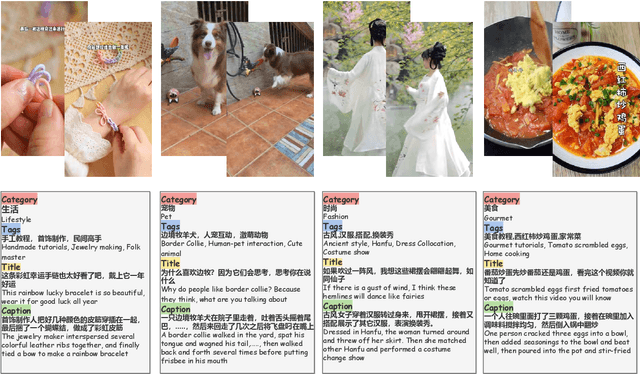
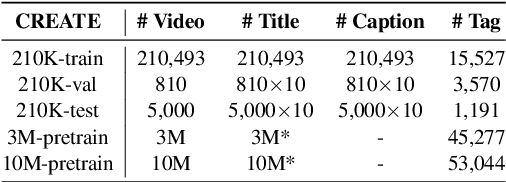
Abstract:Previous works of video captioning aim to objectively describe the video's actual content, which lacks subjective and attractive expression, limiting its practical application scenarios. Video titling is intended to achieve this goal, but there is a lack of a proper benchmark. In this paper, we propose to CREATE, the first large-scale Chinese shoRt vidEo retrievAl and Title gEneration benchmark, to facilitate research and application in video titling and video retrieval in Chinese. CREATE consists of a high-quality labeled 210K dataset and two large-scale 3M/10M pre-training datasets, covering 51 categories, 50K+ tags, 537K manually annotated titles and captions, and 10M+ short videos. Based on CREATE, we propose a novel model ALWIG which combines video retrieval and video titling tasks to achieve the purpose of multi-modal ALignment WIth Generation with the help of video tags and a GPT pre-trained model. CREATE opens new directions for facilitating future research and applications on video titling and video retrieval in the field of Chinese short videos.
 Add to Chrome
Add to Chrome Add to Firefox
Add to Firefox Add to Edge
Add to Edge